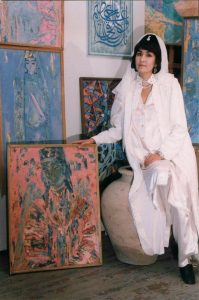 It is necessary to think about her to music Mozart and Vivaldi. To describe her works you can only with the feelings. She is aristocrat in her spirit. The granddaughter of the genius Chingiz Akhmarov, his successor in attitude, artist Shakhnoz Abdullaeva.
It is necessary to think about her to music Mozart and Vivaldi. To describe her works you can only with the feelings. She is aristocrat in her spirit. The granddaughter of the genius Chingiz Akhmarov, his successor in attitude, artist Shakhnoz Abdullaeva.
Since she was born in 1965 Shakhnoz reminded the selective plant whose spiritual growth and beauty absorbed the best. With the special care she was surrounded by her grandfather. For her he was “babam” and for the rest world a star of the fine arts- Chingiz Akhmarov. Well, things could have been different and she could never know him if one day her farther didn`t become a neighbor of lonely artist. “How could it be?”- you can ask. All right, then, first things first.
The father of Shakhnoz came from Namangan. Karimjon intelligent yang man became an orphan in a yang age. The mother of the boy was sophisticated aristocrat who couldn`t power through the disasters of the war and passed away.
The ambitious young man comes to Tashkent to go into the law. It was fate that made him a neighbor of the artist Ch. Akhmarov. Perceptive Akhmarov liked friendly yang man at once. Sometimes he calls Karim to pose as a model. Two generation find connection. After a while, Ch.Akhmarov in uncertain and laconic terms propose to adopt Karim. Combining their daily life two men sanitize the loneliness of each other. After a time, Karim brings a fiancée to their house. Zumrad an owner of rare ethnic beauty immediately becomes a lovely model for Akhmarov.
From the moment of the Shaknoz`s birth indivisible umbilical cord connects her with a grandfather. Traditional pronunciation of her name Shakhnoza the grandfather changes to exotic Shakhnoz what means “a queen of grace” in Iran language. Being a small girl she spends much time in his workshop playing with the dolls made for her by the grandfather. Probably, this very moment of unconscious perception was the most important stage of the development of artist`s personality. In order to understand better the environment of little Shakhnoz it is necessary to know how attractive was a personality of Ch. Akhmarov. Despite of his ascetic temper he was surrounded by the talents of different weight from various spheres of art. The poets, artists, musicians- here is not full list of the people who were the part of the Shkahnoz`s life.
From very childhood the drawn princesses of Shakhnoz attracted attention. Finally starting with a grandfather Shaknoz begins her study in art school. That moment it looked like unconscious impulse of a child. But the time will show it was the destiny.


Graduating the school Shakhnoz starts her education in Tashkent Art and Theater Institute at the faculty of book graphic. In addition to standard subjects: figure, fine art, composition the faculty included many complicated subjects. The students were studying: linocut (engraving on linoleum), lithography (drawing on stone), etching (engraving on metal), font, industrial graphic. Not traditional for classic art education allow to Shakhnoz to form deep knowledge not only about the color but also in composition. Despite the active process of education Ch. Akhmarov rests her main mentor. The influence of Ch.Akhmarov was significant and gentle at the same time and looked more like the interesting journey for his granddaughter. Because he understood as nobody else that the forming of unique style, independent spirit of artist can`t stand strict frameworks and teachings. According to the words of Shakhnoz, specially this gentle influence was the most important in her life. The grandfather introduced her with the world of art. The center of the world art for Akhmarov was Italy. Fra Angelico, Piero della Francesca, Giotto di Bondone changed attitude of yang Shahnoz. She also was impressed by the art of Kamal al-din Bihzad, Andrey Rublev, Vermeer, Matisse, Pierre Bonnard, monumental art of Afrasiyab and Penjikent, Indian art of “ Adjant”.
Guidelines of the grandfather had not only professional but also life character. His sufi restraint he explained that besides our souls we can take noting to another world. And whatever happened in this life bad or good he encouraged Shakhnoz to follow eternal saying of king Salamon “And this will pass”. Graduating from the institute Shakhnoz as an art redactor began her work in printed publication “Apprentice”. After nine months of work she suddenly understood that the only her calling is to create without borders as a free artist. The inspiration for her art Shakhnoz draws from motifs of the world mythology, cultural traditions and customs of the people of Central Asia, that worried her from the childhood. The special place in her art take the images and ceremonies of zoroastrism.

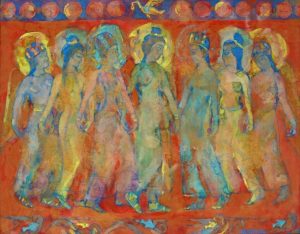
The theme of round dance we repeatedly meet in story lines of the artist. And the interest to this element lies not only in drawing of cultic ceremony but in wish to stop movement in time. The mystery of the movement in Shaknoz`s works give absolutely precise picture how smoothly raises a wrist of arm, how easily and firmly goes down a foot and how graceful a turn of a head.
 Technically to draw a movement as difficult as emotions and time. But specially these elements Shakhnoz reveals on the unexcelled level. Catched early period of art of the granddaughter Ch. Akhmarov emphasized: “I am strong in lines and you are in colors”. Knowing a color as the science helps her to share with very sophisticated ideas. And it only seems that you see emotionally laid brush strokes which hide detailed analytics of harmonious correlation of colors. Studding early period of artist`s art it is necessary to mention one feature. Thanks to skillful game of colors, the pictures have miraculous character. The accurately described ideas on her pictures always hitting at the spirit of the time and images of old, long forgotten Asia, creating association.
Technically to draw a movement as difficult as emotions and time. But specially these elements Shakhnoz reveals on the unexcelled level. Catched early period of art of the granddaughter Ch. Akhmarov emphasized: “I am strong in lines and you are in colors”. Knowing a color as the science helps her to share with very sophisticated ideas. And it only seems that you see emotionally laid brush strokes which hide detailed analytics of harmonious correlation of colors. Studding early period of artist`s art it is necessary to mention one feature. Thanks to skillful game of colors, the pictures have miraculous character. The accurately described ideas on her pictures always hitting at the spirit of the time and images of old, long forgotten Asia, creating association.
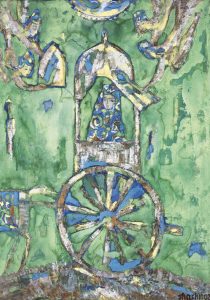
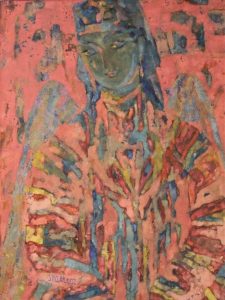
All the pictures of Shakhnoz carries away the viewers to the past. The author misses the time and the places where she never lived. Shakhnoz confess that somewhere inside she feels herself as the habitant of ancient Nishapur or Isfakhan. In the author’s opinion the conditions of living for women were much harder in the past. Here wherefrom comes irrepressible wish to endow the characters of women with exquisite beauty and halo of sublimity. This is a kind of compensation from artist for all bitterness befallen the women. The completed image of Shaknoz`s heroine is virtuous, diffusing calmness, frail and strong at the same time. And no matter who is drawn on the picture a dancer, a queen or an angel. They all streak of queen trait and spirituality in their characters.
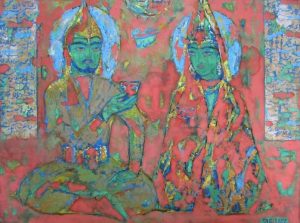

The heroines closely related with inner world of the artist, her life experience and philosophy. The first impression about Shaknoz is very controversial. The delicate constitution, elegant manners, not only a speech but even a laugh full of the calmness. The spiritual and laid-back character harmonically coexist with earthly and not easy life of the artist. Her labor is not serene amusement to romantic music in conditions of creative impulses. Shaknoz live by the principles leaved by her grandfather “The success consists from 99 % of labor and 1% of talent”. “Or you push yourself or you will get the “women`s works”- frankly confesses the artist. She bravely states that doesn`t dream about the serene ageing as the most of us. “I dream to be with my brush until the last days”- confesses Shakhnoz. She clearly remembers the last days of Ch. Akhmarov. On the eve of his death he was spending every day with easel devoting himself to his vocation until last minute.
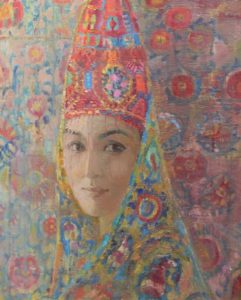
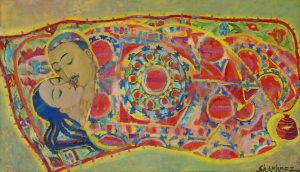
Almost in every picture Shakhnoz elegizes on name “Woman”. Quoting the words of Whitman: «A man is great on the earth and in centuries but every iota of his greatness started from the woman”. Shakhnoz her agreement expresses in her pictures. The most genius contradiction in the world is the woman. “The woman changes her color depending on how to treat with her”- Shakhnoz thinks. «Injure her and you will see all shades of grey, caress her and she will share with you with all the flowers that bloomed in her soul». So treat a woman like an angel and queen chants Shakhnoz in her works.
The heroines of Shakhnoz these are collected characters inspired by chance meetings. The contemporary works of the artist differ with the clearer lines from the works of her early period. But even these earthly heroines the artist makes like from the “past”. Using technical methods, the artist knowingly points to the distance between heroes of her pictures and present time.
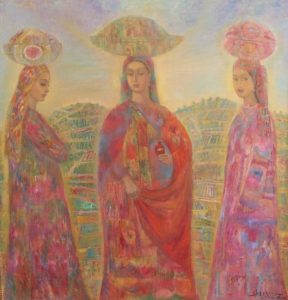
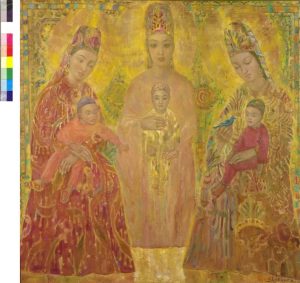
The special attention reserves the wardrobe of her heroines. It will be absolutely fair to say that even the most experienced weaver didn`t create such tissues. The deep and worm colors emphasize the fragility of her heroines, creating the fairy aura.

About the main question in her art, about inspiration Shaknoz don`t talk enough. And it is easy to understand as a lot of factors beginning from the listened melody to genetic memory influence on this process. According Shakhnoz`s opinion the information saving in our genes can’t disappear anywhere and influence on our lives. Perhaps the artist`s genes can explain her love to ancient Asia. The inspiration can’t to prevent about its coming. That is why Shakhnoz is always ready to make an etude. Sometimes the situations turn very curious. One of them happened on New Year eve, when Shaknoz prepared holiday meals for the family. In one second she found herself thinking about still life created on her table. At the same moment she forgot about all preparations and rushed to draw.
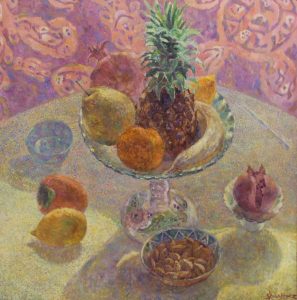
Shaknoz didn`t looked for her vocation. It found her itself. Vocation is a gift. It doesn’t come alone. It comes with absolutely confidence that your way is clear, that your spirit is strong and the heart is open. You accept who you are with all obligations and responsibility. What can be more precious than the truth that with you from the birth? And there is no need for any explanations. Every picture is your dialog with the world, your mission, your vocation!

 Language
Language